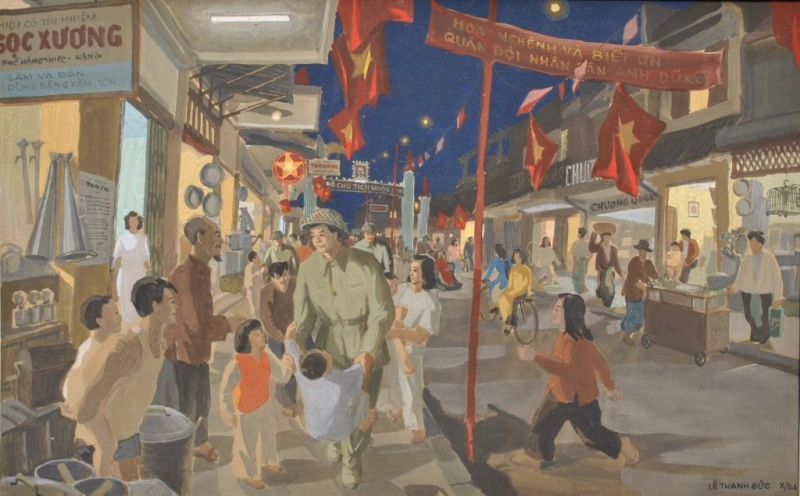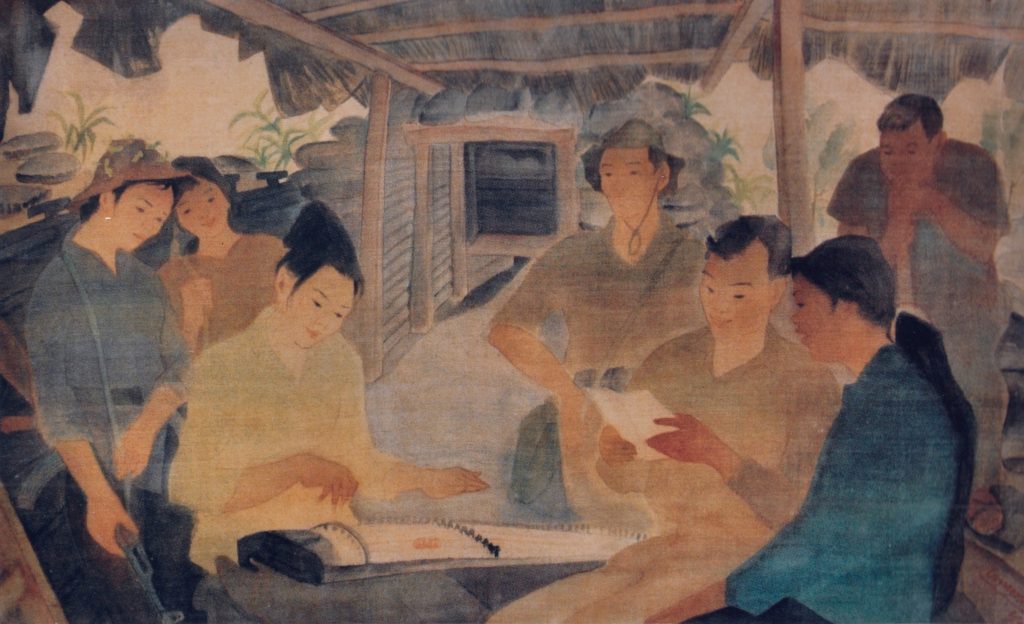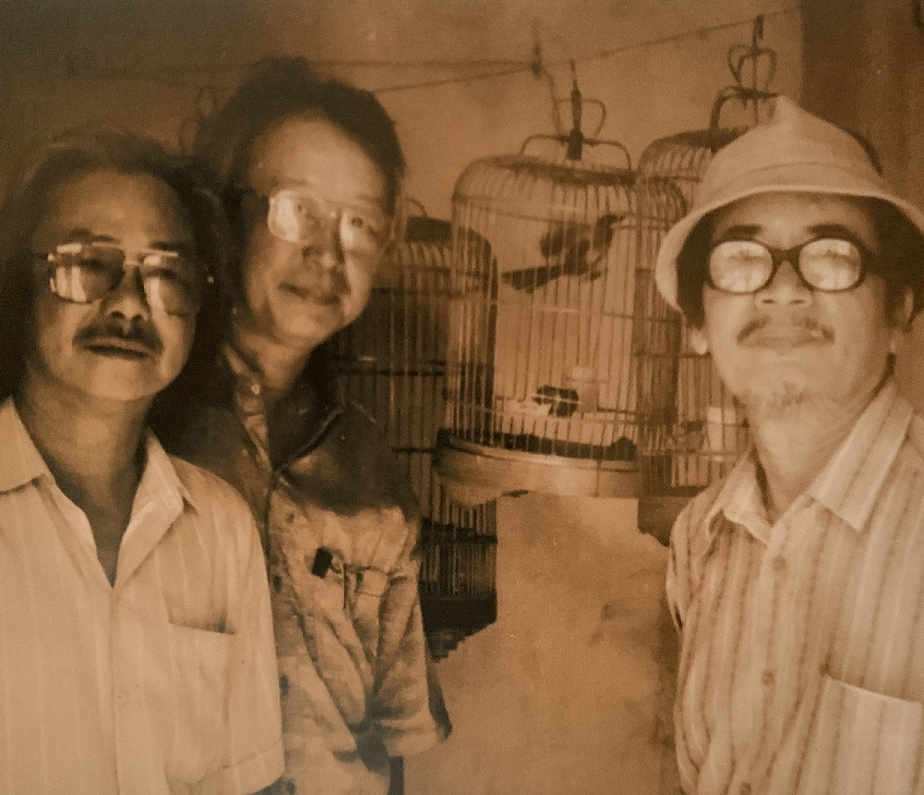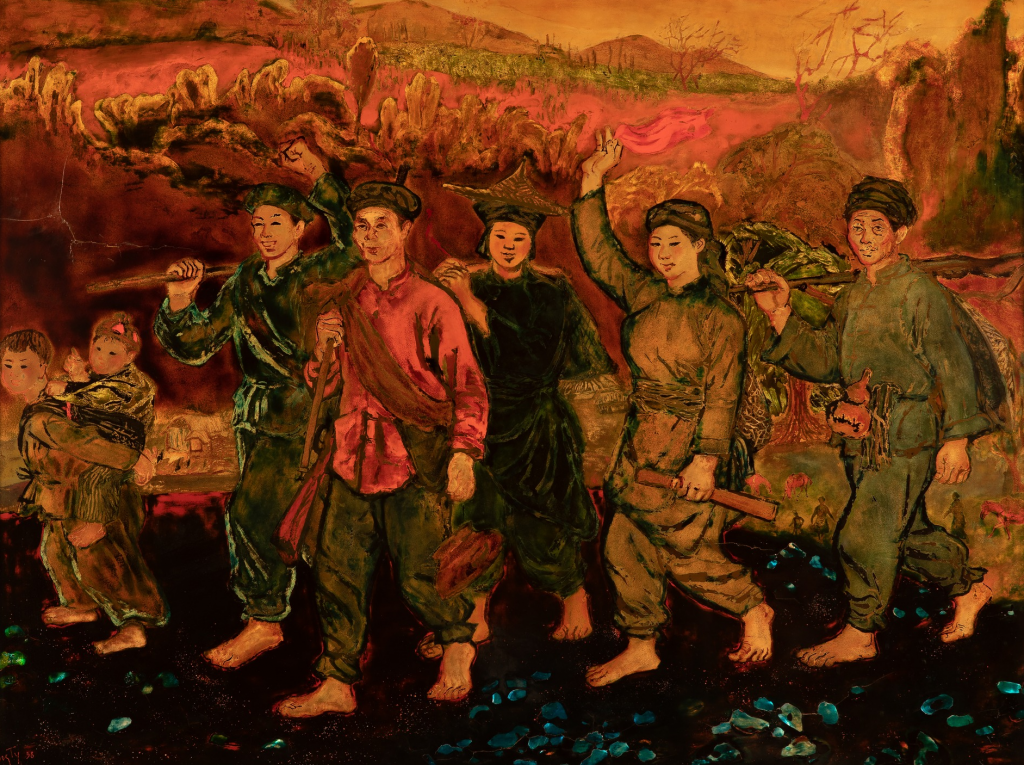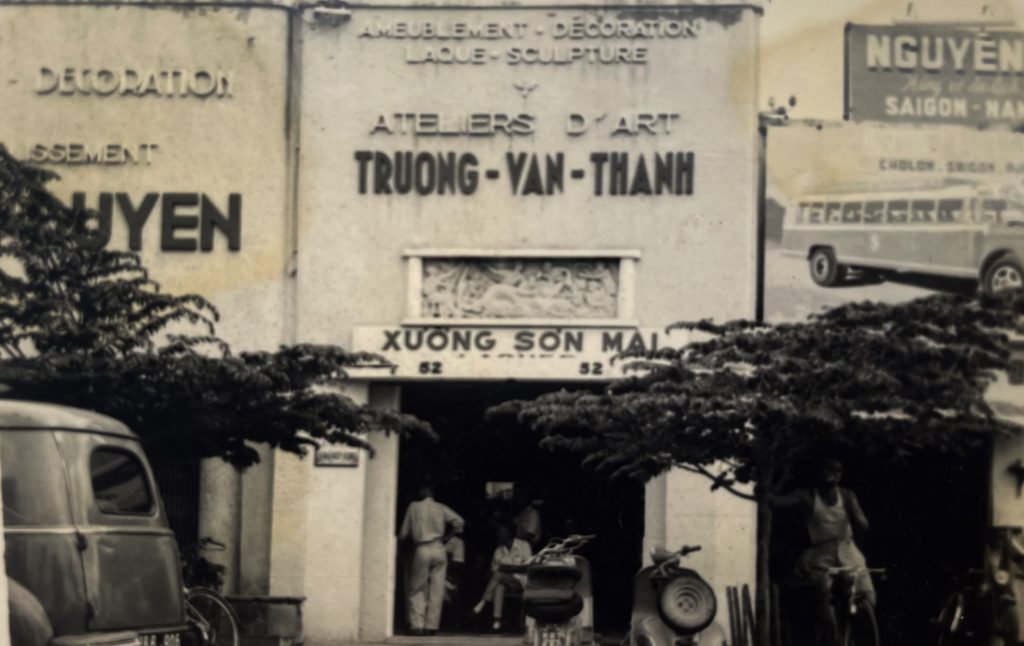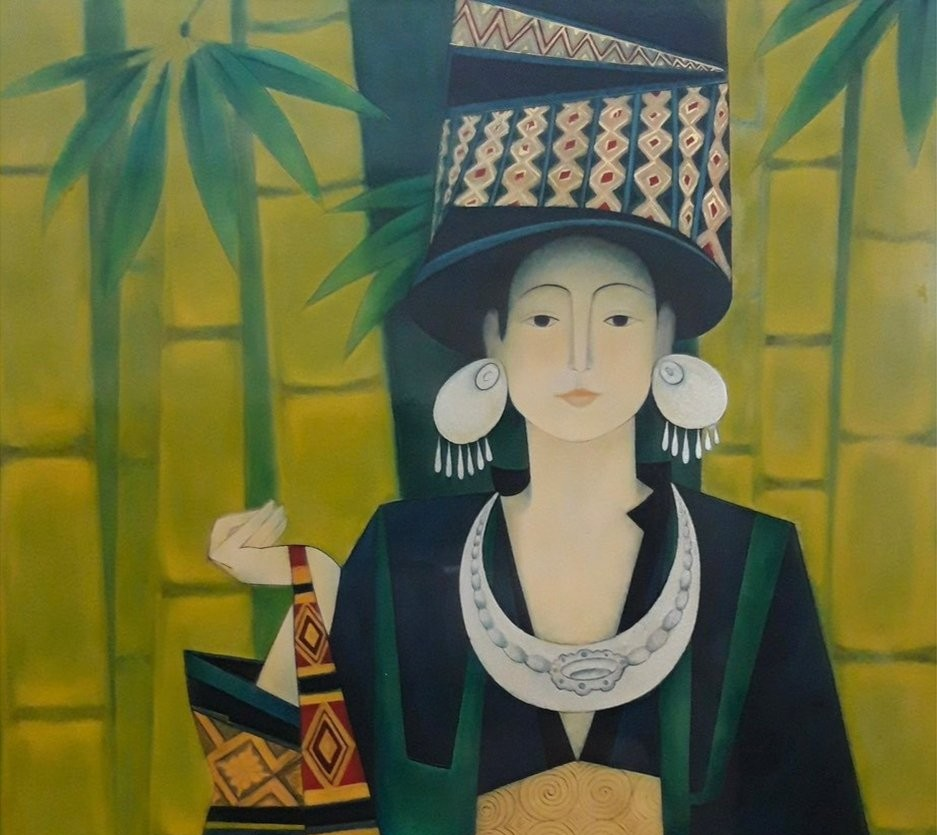The 48th anniversary of the Liberation of the South and the unification of the country and the 133rd anniversary of President Hồ Chí Minh’s birthday on May 19 are coming. I am moved to remember the memories of that time when I was a student, about painter Nguyễn Cao Thương, a long-time Southern friend of my grandfather – lacquer artisan Đinh Văn Thành from the 60s to the 70s of the last century.
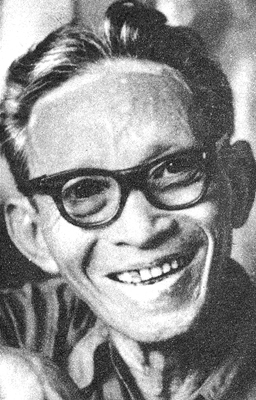
Painter Nguyễn Kao Thương (1918 – 2003). Source: from the article “Nguyễn Kao Thương – who named Đồng Nai School of Decorative Arts” by Nguyễn Văn Thông and Nguyễn Minh Anh, published in Fine Arts Magazine on August 14, 2019.
The first time I met painter Cao Thương was when I followed my grandfather to his house, it was around the summer of 1966 when I was on vacation, I was evacuated to my hometown to live with my grandparents in Hạ Thái lacquer village, along the Tô Lịch river, Hanoi suburb. My grandfather told me: we come to visit a Southern painter who is in the art school (currently Vietnam University of Fine Arts). Then my grandfather rode an old bicycle with a crooked handlebar, took me from Hạ Thái hometown to Hanoi, walked along the bicycle through the school gate. We walked across the wide courtyard of the School of Fine Arts, at the end of the narrow entrance, turned right, stepped on the rickety wooden stairs, passed along a dark corridor of the second floor loft, then my grandfather knocked on the door.
Opening the door to greet us was a muscular man, limping, dark skinned, square face, high forehead, especially with very big round eyes, he smiled: “Hello, Thành, you two come here.” I eagerly looked at the narrow room where he lived and worked, curious and surprised, “everything is strange”. The room had a low, narrow ceiling, in the middle was an easel with a large picture in progress, close to the wall was a tall and narrow individual bed, a chair by the head of the bed, on the chair was a “white as a ghost” skull. The wall diagonal to the bed had a large window without bars, I looked out to the Nam Bộ street below, there was a train whistle in the distance; At the foot of the wall, he left a pipe smoker, on the rickety old wooden floor there were brushes and paints of all kinds. It was the place of living and working of an artist gathered to the North, personal belongings were too sketchy, if we couldn’t say nothing, I felt the room messy, only focusing on painting.
Coming to his home with my grandfather, everything was strange, so I asked him: Why did you leave the skull at the head of the bed? He told me that he had to go down to Văn Điển cemetery to ask for that woman’s skull so that he could study and teach. Years later, when I had the opportunity to visit, I saw that over time the skull also darkened, cracked and looked like an old piece of cracked cardboard and finally it was lying in a corner on the floor. Later, through the materials that he sent to my grandfather’s house, I saw that he studied the subject “Human anatomy” very deeply in order to teach and paint specifically and accurately each human movement. The painter was a very serious, meticulous and methodical artist.
When talking to us, he moved his finger up to the window sill and showed it to me, then said that when he studied painting in the Soviet Union, in the dormitory, he cleaned every day, the rags were clean white, not dirty like that, because he didn’t have time so he let it be like that. I asked him why his legs were limping, he pointed to the pistol holster left at the table and joked to me and my grandfather: on the days of the resistance war against the French, he climbed a tree with a rifle and set fire to the enemy’s plane (later I learned it was a RPK), in a battle, the enemy shot him and injured his heel, which could not be cured, so he limped, he was a third-rate wounded soldier and then gathered to the North, the pistol he returned to the unit and the holster he kept as a souvenir. So uncle Cao Thương was a soldier and also the first painter to shoot down a French plane on the South battlefield. Those were the first years of evacuation against the destructive war of the American aggressors in the Socialist North.
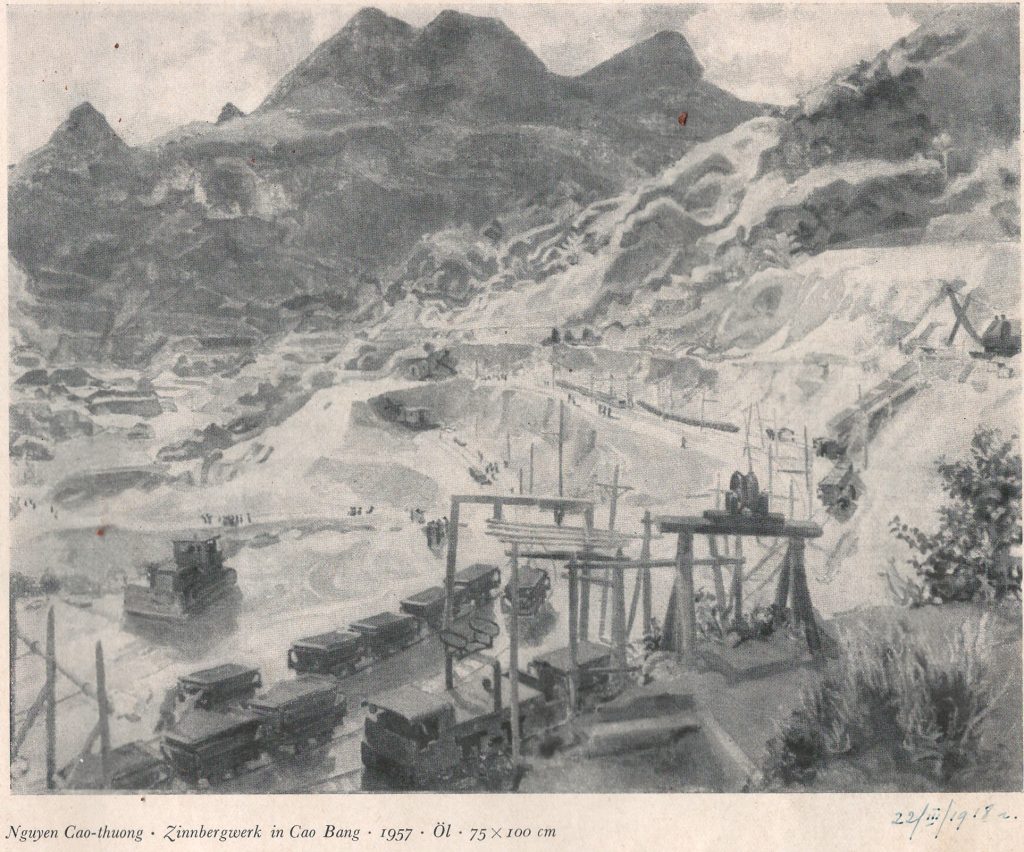
Tin mine in Tĩnh Túc, Cao Bằng. 1957. Oil. 75×100 cm. Source: Bildende Kunst magazine of German Democratic Republic, November 1959, page 791.
From 1967 to 1968, painter Cao Thương studied and observed carefully, sketched in great detail the actual models, painted over and over again to build character images for his great, majestic paintings. With passionate patriotism, deep hatred for the enemy and infinite gratitude to dear Uncle Hồ, painter Nguyễn Cao Thương was deeply imbued with Uncle Hồ’s words to writers and artists: “Culture serves the people, taking the people’s happiness and the nation’s happiness as the basis”, “Art must be close to life, painters cannot imagine whatever they want, the people criticize then say that people don’t know anything” and since then the artist had gone to practice at major construction sites and also at the Quảng Bình fire line with soldiers shooting American enemy planes, to complete monumental works.
Once around the summer of 1967, my grandfather let me go with him to the studio where painter Cao Thương taught at the School of Fine Arts to lend him my grandfather’s light khaki overcoat. The school’s studio was both high and vast. I saw uncle Cao Thương standing in front of a large, unfinished painting. He greeted my grandfather, then told him to immediately put on that khaki coat and showed him a few poses as a model to study and draw directly the outline of the main character in the picture. Then he asked my grandfather to lend him the khaki coat to make a specific model of Uncle Hồ’s visit to the air force.
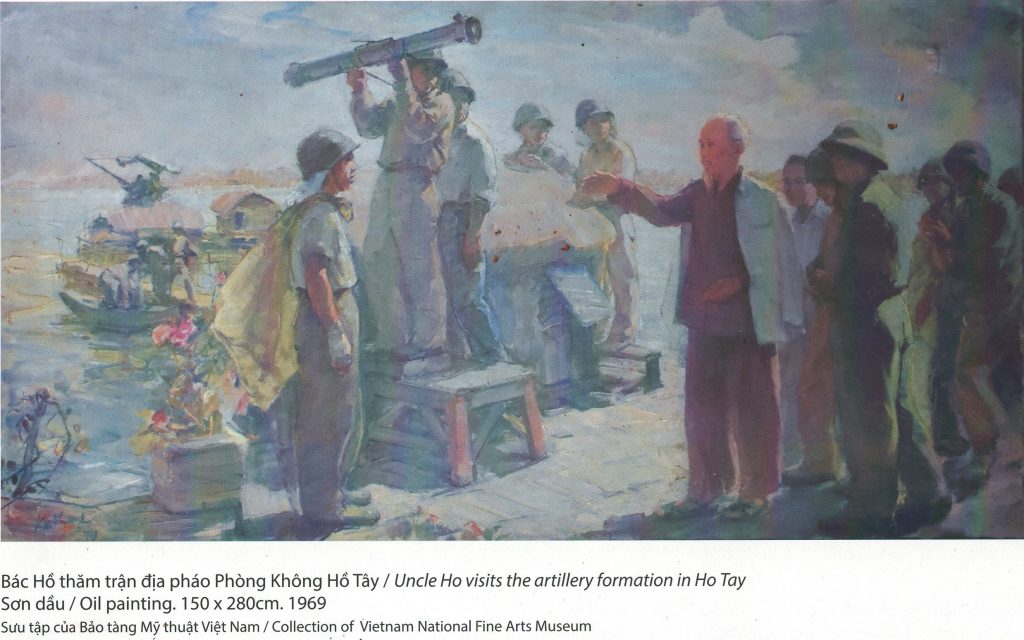
Uncle Hồ visits the West Lake air force artillery battlefield. Oil. 150×280 cm. 1969. Source: The book “Painter Nguyễn Cao Thương” by author Mã Thanh Cao, page 14, Fine Arts Publishing House.
Later, I was able to see directly the painting “Uncle Hồ visits the West Lake air force artillery battlefield” displayed at the Vietnam Fine Arts Museum, a monumental oil painting, the scene of Uncle Hồ visiting the artillery soldiers like a father visiting his children. The oil painting showed the soldiers in each battle position, with the oil material that made a strong impression through the decisive and precise movements and gestures of the soldiers in battle. The artillery was clear in every detail, exuded the spirit of urgency, ready to fight bravely and shoot the invading American aircraft.
Painter Cao Thương had painstakingly studied and meticulously sketched the characters in the picture, from the standing postures, fighting movements of the soldiers and especially the image of Uncle Hồ shown in vivid detail with a deliberate standing posture, gentle and affectionate with the soldiers. Through the work, with enthusiastic artistic labor, the painter and soldier Nguyễn Cao Thương conveyed the infinite affection and gratitude of a son of the South “Citadel of the Fatherland” to Uncle Hồ, the old father of Vietnam nation. The painting “Uncle Hồ visits the West Lake air force artillery battlefield” by artist and soldier Nguyễn Cao Thương has high ideological and artistic value, which highly expresses the revolutionary heroism of our people in the period against the destructive war of the American aggressors in the Socialist North.
In the years 1966 – 1967, the war of destruction by the American enemy’s air force became more and more fierce, the North concentrated all human and all strength on the front line to defeat the invading American aggressors. The fire line from Thanh Hóa to Quảng Bình was getting hotter and hotter, drew all forces and means of support to the front line, and artists and writers also accompanied the whole country side by side with the forces directly fighting. One sweltering, hot summer night in 1967, my grandfather asked me to go to the alley with him to meet Uncle Cao Thương.
He was wearing a majestic helmet like a soldier riding a Soviet bicycle, a few men pushing a bullock cart full of wooden boxes, paper boxes and hurriedly brought those, following us, immediately moved to my grandfather’s house. He only had time to tell my grandfather that he had to rush to the fire line of the old area four to directly painting, he asked my grandfather to keep the books and documents that he would take later.
So, during my high school years at the evacuation place of my hometown, I was free to look at painter Cao Thương’s books, and my interest in learning about painting and visual arts had been there. Through reading books, books on human anatomy mainly in Russian, and his documentary notes, I have seen that he is a person who was very passionate about reading and seeking to use the knowledge he had read for sketches and later for major works.
From the South battlefield to the North, in order to be able to absorb knowledge in the field of painting, he quickly studied culture to complete the cultural knowledge of high school in a very short time. After that, he studied Russian passionately in order to have foreign language to acquire knowledge of visual arts abroad (the Soviet Union at that time). He was a soldier who bravely shot down French plane with his rifle and also a talented artist who was passionate about painting, I admire him very much.
The painting books of painter Cao Thương made me understand: he went to the Soviet Union to study painting at the Moscow University of Fine Arts named V. I. XURIKOV (a famous Russian painter) in 1960 – 1962 and then in the books and documents, he signed his name as Kao Thương (in Russian), when he returned home, perhaps out of habit he took both Russian and Vietnamese signature: Kao Thương since then.
During the New Year in 1968, my grandfather invited painter Kao Thương to our hometown of Hạ Thái to celebrate Tết and make lacquer paintings. My grandfather spent a space in the middle of the house with a bamboo screen to shield it from rain and sunlight to place a lacquered board that preliminary painted scenes of workers installing high-voltage power lines overhead, below was the sun shining, so majestic and beautiful, the lacquer painting was nearly entire the middle of the house. My grandmother made traditional dishes for Tết in the North such as frozen meat, braised fish, bean soup, lean pork pie, square sticky rice cake… to treat the distinguished guest from the South. On that New Year’s Eve, in the resounding firecrackers of New Year’s Eve, my grandparents’ family and painter Kao Thương listened to the Voice of Vietnam radio to listen to Uncle Hồ’s warm voice wishing:
Last year was a great success
This year the frontline wins even more
For independence, for freedom
Beat the American, beat the puppets
Go ahead, fellow soldiers
For the spring reunion
After Uncle Hồ’s New Year’s greeting was good news, the Total Attack Mậu Thân Spring throughout the South won, painter Kao Thương excitedly brought a bag of special sweets to celebrate, talking with my grandparents till morning. On the morning of the first day of the New Year, I saw that uncle Kao Thương had something to motivate him. He took a pen to draw, some gold, silver, eggshell… passionately painted on the half-full board. My grandfather stood next to him to watch him paint and discussed professional experiences. I saw him carefully put eggshell on electric workers’ hats, and then the gold for the sunshine… The painting wasn’t finished, but I was able to admire the scene of strong workers installing high-voltage power lines, liberal against a vast sky full of sunshine. Using lacquer material for the painting made a strong impression, praising the beauty in the labor of the northern socialist electricity worker who focused on the task of ensuring that the electricity grid would not be lost for the sake of the people in the South.
In the years 59 – 60 of the last century, uncle Kao Thương was the Vice Principal of the Vietnam Fine Arts School (now Hanoi University of Industrial Fine Arts), and my grandfather was a lacquer teacher of the school. This was the time before the time that peace was restored in 1955. Uncle Kao Thương formerly attended the Indochina Fine Arts College during the French colonial period, later returned to the South as a soldier and then gathered to the North, so when he met my grandfather again, he was very happy because he could continue to learn from my grandfather’s lacquer experience.
Painter Kao Thương was very passionate about painting and often explored to express with different materials. In particular, the artist was very interested in traditional lacquer paint material, he wondered how to use high-value materials such as gold and silver and common materials such as eggshells to make them “proper”. My grandfather often discussed with artists how to use high-value gold and silver materials to make them “proper”, gold and silver respect the elegance and nobility, if using for the right highlights of the painting; Even though one painting have a lot of gold and silver, if used in the wrong place, their artistic value will be low. Lacquer painting is also valuable in that, over time, the scene in the painting has more depth, wonderful layers.
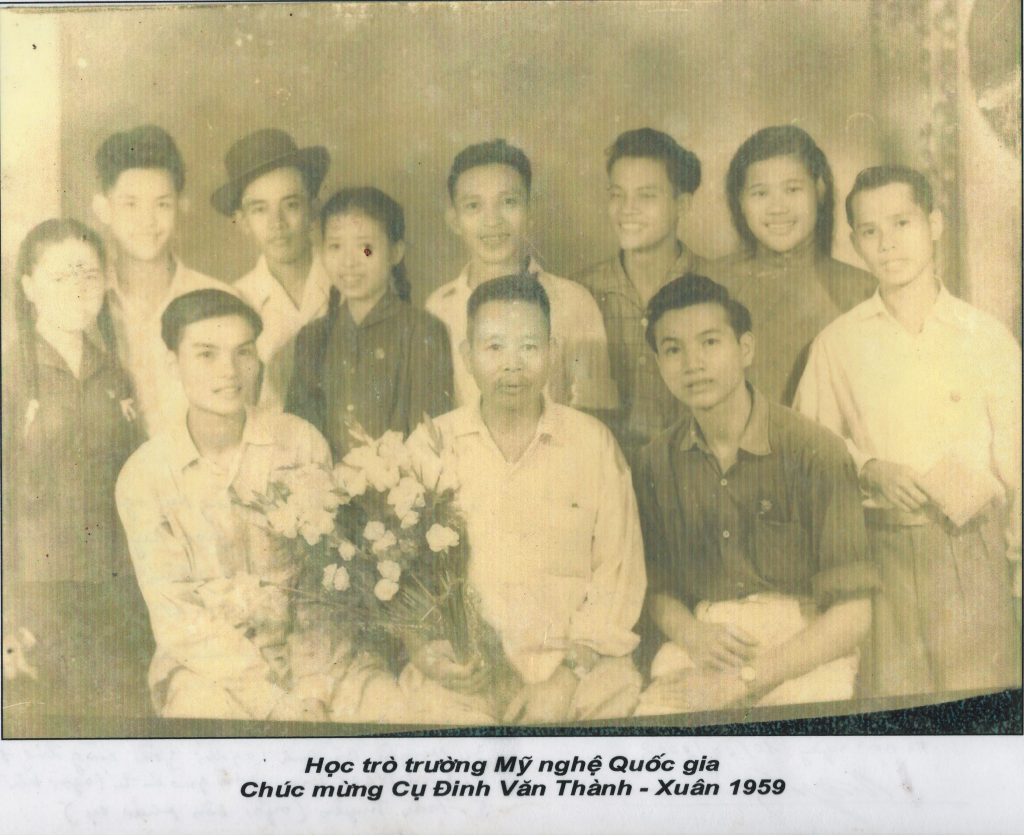
Painter Nguyễn Kao Thương, Vice Principal of Vietnam Fine Arts School and students of Vietnam Fine Arts School congratulated to lacquer artisan Đinh Văn Thành on the occasion of the New Year 1959 (Painter Nguyễn Kao Thương standing right behind Mr. Thành. Collected by artist Nguyễn Xuân Nghị for Mr. Thành’s family). Source: Master Nguyễn Xuân Nghị – painter, lecturer at the University of Industrial Fine Arts, collected for the family of Mr. Thành (Mr. Thành’s grandson provided the photo).
In the summer of 1968, I was able to go with my grandfather to uncle Kao Thương’s house again. As soon as I got to the door, I looked and saw an upside-down painting on a high pedestal, and he meticulously used a steel blade to erase the long streaks. Because I have lived with my grandfather who specialized in lacquer, I immediately realized that the painting which was eaten by weevils was being erased by uncle Kao Thương. I also realized that was the painting he made during Tết and not finished, so I naively asked: “Uncle, how long does it take you to make it, can it be repaired?”
He was silent for a while and then said to my grandfather: “It is true that good wood is better than good paint, this board I chose the wrong wood, so even though I’m careful, it still gets damaged by weevils, a lot of labor, gold and silver are expensive but it should be discarded.” I also felt sorry for the excitement, artistic labor, and his mind was devoted to the lacquer painting made during the Tết holiday in my hometown, which was damaged and must be thrown away. Indeed, after that, I never saw the painting displayed or introduced anywhere. A lacquer painting work in which he put his heart, time and artistic labor, but when the quality of the painting was not guaranteed, he definitely discarded it.
Years of living and working in the North, uncle Kao Thương lived alone with no wife nor children in a small and simple room, a window looked down Nam Bộ street (now Lê Duẩn street), with only minimal items: a high personal bed, an easel often placed large sketches of paintings occupying most of the space. All the time, his mind was focused on teaching and creating art, hoping to return to his hometown soon to contribute.
His passionate patriotism, his deep hatred for the French and American enemies and his love for the people of the country were clearly shown in his typical paintings, which I have seen as: “Tin mine Tĩnh Túc – Cao Bằng”, made in 1957, “Uncle Hồ visits the West Lake air force artillery battlefield”, made in 1969, watercolor sketches of Uncle Hồ’s stilt house at the Presidential Palace. Especially the large-scale lacquer painting “Workers installing high-voltage power lines” which fortunately I was able to see directly during the artist’s painting process, unfortunately, for the above reason, this work was never displayed.
On April 30, 1975, when the South was completely liberated, painter Kao Thương returned to his hometown after many years of separation. Since then, I have not been able to see him again, but in my mind, feelings, and old memories are still intact for him. Remembering painter Nguyễn Kao Thương is remembering the uncle who was very close to my grandfather, a lacquer artisan for a long time, a loyal friend, “well raised, well studying”, the kind, rustic uncle with a warm Southern voice.
Later I learned that painter Nguyễn Kao Thương was the first principal of Đồng Nai High School of Decorative Arts, the painter was born on March 22, 1918 and died on March 28, 2003 in Hồ Chí Minh City, at the age of 85, in 2012 the artist was posthumously awarded the State Prize for Literature and Art by the President of the Socialist Republic of Vietnam.
Painter Nguyễn Kao Thương was first a soldier, painter, a real revolutionary artist with a passion for art who used his painting talent to serve the cause of building socialism and fighting the destruction war by the American enemy in the North, liberating the South and reunifying the country. The artist pondered and experimented with bringing the Socialist realism art movement of that period into his paintings. The artist went on field trips to large construction sites such as tin mine in Tĩnh Túc, Cao Bằng, Thái Nguyên Iron and Steel Area, visited Pác Bó relic site, and with soldiers on the battlefields of Thanh Hóa and Quảng Bình artillery… to directly paint, experience and get materials for future major works. In life, the artist did not pay attention to daily activities, but in the creation, he was very meticulous (such as a board that was almost finished but was unable to be kept because of the weevils, so he resolutely discarded it).
Southern soldier and painter Nguyễn Kao Thương was imbued with Uncle Hồ’s saying: “Culture and art are a front, you are soldiers on that front”, all his life, he fought bravely with weapons on the battlefield, and with weapons of art on the cultural and artistic front. This article I write about painter Nguyễn Kao Thương, paying homage to him, a son of the South, the first painter who shot down a French enemy plane with a rifle, a talented painter who was once attached to my grandfather – lacquer artisan Đinh Văn Thành and painters of the Indochina Fine Arts School in the North.
Hà Nội, April 15, 2023
Written by author Nguyễn Đình Đặng
Copyrights belong to Viet Art View


